|
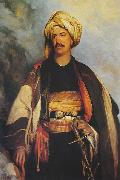 |
Robert Scott Lauder
|
|
Robert Scott Lauder (25 June 1803 - 21 April 1869) was a Scottish mid-Victorian artist who described himself as a "historical painter". He was one of the original members of the Royal Scottish Academy.
Lauder was born at Silvermills, Edinburgh, on 25 June 1803, the third son of John Lauder of Silvermills (died 1838), Burgess of Edinburgh and proprietor of the tannery at Silvermills, by his wife Helen Tait (d.1850). After attending the Royal High School he went to London, where his eldest brother William was engaged in the family business.
He returned to Edinburgh about 1826 and was elected one of the original members of the Royal Scottish Academy in 1830. On 9 September 1833 at St.Cuthberts in Edinburgh he married Isabella Ramsay Thomson and they then went abroad, accompanied by his younger artist-brother, James Eckford Lauder. Robert studied for some years in Rome, Florence, Bologna, Venice and Munich.
Lauder returned to London in 1838 where he lived for several years, where his three children - Isabella, John, and Robert, were baptised at St.Thomases Church, Southwark, in 1840, 1841, and 1844. Whilst in London he exhibited at the Royal Academy and competed in the Westminster Hall competition of 1847, sending his Christ walking on the Sea, which was subsequently purchased by Lady Angela Burdett-Coutts, 1st Baroness Burdett-Coutts. He became the first president of the short-lived National Institution of Fine Arts and also exhibited there.
He later removed back to Edinburgh in 1849 where both his sons - Robert Scott Lauder (born 1844), who became a physician, and John Thomson Lauder (1841-1865) - attended the Edinburgh Academy. Sir Walter Scott's novels provided him with subjects for many of his most successful historical paintings. About 1860 he suffered a paralytic stroke and did not practice after 1861. He died at Edinburgh from a bout of bronchitis on 21 April 1869, still paralysed. He is buried in Warriston Cemetery in Edinburgh. |
 |
Robert Loftin Newman
|
|
(November 10, 1827 - March 31, 1912). was an American painter and stained-glass designer. He specialized in oil on canvas as his medium. He is sometimes associated with Albert Pinkham Ryder as a painter of mood. His works include Good Samaritan, painted in 1886, Flight into Egypt, Harvest Time, Sailboat Manned by Two Men, and The Bather.
He was born in Richmond, Virginia and moved to Clarksville, Tennessee when he was 11 years of age. Later, as a young adult, he studied art in New York, England, and France. Newman served briefly as an artillery lieutenant for the Confederate Army during the American Civil War. He died of asphyxiation from a gas leak from a stove on March 31, 1912. |
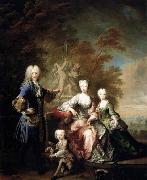 |
Robert Levrac Tournieres
|
|
Thomas William Robertson (9 January 1829 ?C 3 February 1871), usually known professionally as T. W. Robertson, was an Anglo-Irish dramatist and innovative stage director best known for a series of realistic or naturalistic plays produced in London in the 1860s that broke new ground and inspired playwrights such as W.S. Gilbert and George Bernard Shaw. |
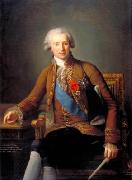 |
Robert Lefevre
|
|
(24 September 1755, Bayeux - 3 October 1830, Paris) was a French painter of portraits, history paintings and religious paintings. He was heavily influenced by Jacques-Louis David and his style s reminiscent of the antique.
Robert Lefevre made his first drawings on the papers of a procureur to whom his father had apprenticed him. With his parents' consent, he abandoned this apprenticeship and walked from Caen to Paris to become a student of Jean-Baptiste Regnault (in whose studio he met and became friends with Charles Paul Landon). At the 1791 Paris Salon he exhibited his Dame en velours noir, the point of departure for his reputation. Lefevre made 1805 the portait empress Josephine. 1807 manufactured the counterpart of emperor Napoleon Louis-Andre-Gabriel Bouchet. Napoleon gave both paintings to the city Aachen 1807, where they are today in the city hall and decorate the entrance hall. His other portraits of Napoleon, Josephine, Madame Laetitia, Guerin, Carle Vernet (a portrait which is now at the Louvre) and pope Pius VII made him a fashionable portrait artist and one of the main portraitists of the imperial personalities, a reputation sealed by his portrait of Napoleon's new wife Marie Louise. |
 |
Robert Lefere
|
|
Robert Jacques François Faust Lefevre (24 September 1755, Bayeux - 3 October 1830, Paris) was a French painter of portraits, history paintings and religious paintings. He was heavily influenced by Jacques-Louis David and his style s reminiscent of the antique.
Robert Lefevre made his first drawings on the papers of a procureur to whom his father had apprenticed him. With his parents' consent, he abandoned this apprenticeship and walked from Caen to Paris to become a student of Jean-Baptiste Regnault (in whose studio he met and became friends with Charles Paul Landon). At the 1791 Paris Salon he exhibited his Dame en velours noir, the point of departure for his reputation. Lefevre made 1805 the portrait empress Josephine. 1807 manufactured the counterpart of emperor Napoleon Louis-Andre-Gabriel Bouchet. Napoleon gave both paintings to the city Aachen 1807, where they are today in the city hall and decorate the entrance hall. His other portraits of Napoleon, Josephine, Madame Laetitia, Guerin, Carle Vernet (a portrait which is now at the Louvre) and pope Pius VII made him a fashionable portrait artist and one of the main portraitists of the imperial personalities, a reputation sealed by his portrait of Napoleon's new wife Marie Louise.
On the Bourbon Restoration Robert Lefevre painted a portrait of Louis XVIII for the Chambre des Pairs and received the cross of the Legion d'honneur and the title of First Painter to the King, losing the latter on the July Revolution. He painted a large number of portraits and history paintings. The main example of his portraits are those of Malherbe (Bibliotheque publique de Caen), Charles X, the duchesse deAngouleme, the duchesse de Berry, Charles-Pierre-François Augereau duc de Castiglione (Musee de Versailles), and of Dominique Vivant-Denon. Two of his mythological paintings - Love sharpening his arrows and Love disarmed by Venus (t. 1,84 sur 1,30 ), were engraved by Desnoyers - the latter is reproduced in le Nu Ancien et Moderne. His most notable history paintings are his Phocion getting ready to drink hemlock, Roger delivering Angelique, Heloïse and Abelard and a Crucifixion for the Mont Valerien. His last painting was The Apotheosis of Saint Louis for the Cathedral of La Rochelle.
|
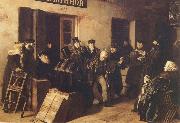 |
Pryanishnikov Illarion
|
|
1840-1894,Russian painter. He studied from 1856 to 1866 at the School of Painting, Sculpture and Architecture in Moscow and subsequently taught there (1873-94). Among his pupils were Sergey Ivanov and Sergey Korovin. Pryanishnikov was among the fifteen founder-members of the Peredvizhniki (WANDERERS) and contributed two works to their first exhibition. His narrative pictures of the 1860s embodied the critical trend in early Russian Realism and focused on the trials and sorrows of the lower classes; his Jokers (1865; Moscow, Tret yakov Gal.) shows a petty clerk performing stunts for the amusement of some wealthy merchants. The Convoy of Empty Sleds (1871; Kharkiv, Mus. F.A.) conveys a fine sense of the bleak winter landscape. His later work added northern scenery and genre scenes to his repertory as in Saviour Day in the North (1887; Moscow, Tret yakov Gal.) and Return from the Fair (1883; St Petersburg, Rus. Mus.). Pryanishnikov is also known for his hunting scenes. In 1893 he became a member of the St Petersburg Academy of Arts. |
 |
Pietro Longhi
|
|
1702-1785
Italian
Pietro Longhi Galleries
Pietro Longhi was born in Venice in the parish of Saint Maria, first child of the silversmith Alessandro Falca and his wife, Antonia. He adopted the Longhi last name when he began to paint. He was initially taught by the Veronese painter Antonio Balestra, who then recommended the young painter to apprentice with the Bolognese Giuseppe Maria Crespi, who was highly regarded in his day for both religious and genre painting. He was married in 1732 to Caterina Maria Rizzi.
Among his early paintings are some altarpieces and religious themes. In 1734, he completed frescoes in the walls and ceiling of the hall in Ca' Sagredo, representing the Death of the giants. Henceforward, his work would lead him to be viewed in the future as the Venetian William Hogarth, painting subjects and events of everyday life in Venice. The gallant interior scenes reflect the 18th century's turn towards the private and the bourgeois.
Many of his paintings show Venetians at play, such as the depiction of the crowd of genteel citizens awkwardly gawking at a freakish Indian rhinoceros (see image). This painting chronicles Clara the rhinoceros brought to Europe in 1741 by a Dutch sea captain and impresario from Leyden, Douvemont van der Meer. This rhinoceros was exhibited in Venice in 1751. There are two versions of this painting, nearly identical except for the unmasked portraits of two men in Ca' Rezzonico version. Ultimately, there may be a punning joke to the painting, since the young man on the left holds aloft the sawed off horn (metaphor for cuckoldry) of the animal. Perhaps this explains the difference between the unchaperoned women.
Other paintings chronicle the daily activities such as the gambling parlors (Riddoti) that proliferated in the 18th century. In some, the insecure or naive posture and circumstance, the puppet-like delicacy of the persons, seem to suggest a satirical perspective of the artists toward his subjects. Nearly half of the figures in his genre paintings are faceless, hidden behind Venetian Carnival masks. Like Crespi before him, Longhi was commissioned to paint seven canvases documenting the seven Catholic sacraments.
Longhi is well-known as a draughtsman, whose drawings were often done for their own sake, rather than as studies for paintings. Pietro's son, Alessandro, was also an accomplished painter.
A paraphrase of Bernard Berenson states that "Longhi painted for the Venetians passionate about painting, their daily lives, in all dailiness, domesticity, and quotidian mundane-ness. In the scenes regarding the hairdo and the apparel of the lady, we find the subject of gossip of the inopportune barber, chattering of the maid; in the school of dance, the amiable sound of violins. It is not tragic... but upholds a deep respect of customs, of great refinement, with an omnipresent good humor distinguishes the paintings of the Longhi from those of Hogarth, at times pitiless and loaded with omens of change". |
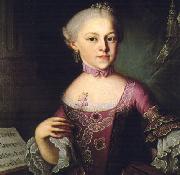 |
Pietro Antonio Lorenzoni
|
|
Pietro Antonio Lorenzoni (1721 - 1782) was an Italian painter who is believed to have painted several portraits of Wolfgang Amadeus Mozart and his family: "The Boy Mozart" (1763), his sister Maria Anna Mozart in "Nannerl as a Child" (1763) and a portrait of their father Leopold Mozart (c. 1765). He arrived in Salzburg, Austria in the 1740s and first wanted to paint Wolfgang and Nannerl. His protege, Johann Nepomuk della Croce, painted a Mozart family portrait in 1780. |
 |
Pieter Leermans
|
|
Pieter Leermans (ca.1635, Leiden - 1706), was a Dutch Golden Age painter.
he was a portrait painter of historical allegories. He is also known as Lieremans
Little is known of his life, but he is considered to be one of the Leiden fijnschilders
|
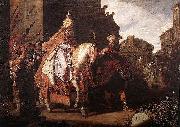 |
Pieter Lastman
|
|
(1583 - 4 April 1633 (buried)) was a Dutch painter . Lastman is considered important because of his work as a painter of history pieces and because his pupils included Rembrandt and Jan Lievens. In his paintings Lastman paid a lot of attention to the faces, hands and feet.
Pieter Lastman was born in Amsterdam, the son of a town-beadle, who was dismissed in 1578 for being a Catholic. His mother was an appraiser of paintings and goods. His apprenticeship was with Gerrit Sweelinck, the brother of Jan Pieterszoon Sweelinck. Between approximately 1604 and 1607 Lastman was in Italy, where he was influenced by Caravaggio (as were the painters of the Utrecht School a few years later) and by Adam Elsheimer. Back in Amsterdam he moved in with his mother in the Sint Antoniesbreestraat, living next to mayor Geurt van Beuningen. Lastman never married although he promised to marry the sister of Gerbrand Adriaensz Bredero. Because of his health Lastman moved in with his brother in 1632. He died the next year and was buried in the Oude Kerk. |
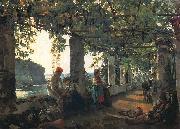 |
Pier Leone Ghezzi
|
|
(Rome, 28 June 1674 - Rome, 6 March 1755) was an Italian Rococo painter and caricaturist active in Rome.
Caricature of composer Antonio Vivaldi by Pier Leone GhezziGhezzi was born in Rome. His father, Giuseppe Ghezzi, (1634-1721), also trained Antonio Amorosi, and was a secretary to the Roman Accademia di San Luca. Pier Leone himself joined the Academy in 1705 and he executed a painting, the Allegory of Gratitude, to be donated to the institution, as was customary.
He was the godson of Carlo Maratta. Pier Leone is known for his frescoes in the Villa Falconieri of Frascati.
His pen and gouache caricatures are much freer in emotion than his state portraiture, and often depict named individuals or professions in satirical fashion.
|
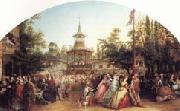 |
Phoebus Levin
|
|
fl. 1836-1878 was born in Berlin but exhibited in London from 1855-1878 |
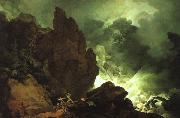 |
Philip James de Loutherbourg
|
|
1740-1812
French (Resident in UK)
Philip James de Loutherbourg Gallery
Philip James de Loutherbourg, also seen as Philippe-Jacques and Philipp Jakob and with the appellation the Younger (31 October 1740 ?C 11 March 1812) was an English artist of French origin.
He was born in Strasbourg, where his father, the representative of a Polish family, practised miniature painting; but he spent the greater part of his life in London, where he was naturalized, and exerted a considerable influence on the scenery of the English stage, as well as on the artists of the following generation. De Loutherbourg was intended for the Lutheran ministry, and was educated at the University of Strasbourg.
As the calling, however, was foreign to his nature, he insisted on being a painter, and placed himself under Charles-Andr?? van Loo in Paris. The result was an immediate and precocious development of his powers, and he became a figure in the fashionable society of that day. In 1767 he was elected into the French Academy below the age required by the law of the institution, and painted landscapes, sea storms, battles, all of which had a celebrity above those of the specialists then working in Paris. His debut was made by the exhibition of twelve pictures, including Storm at Sunset, Night, Morning after Rain.
He is next found travelling in Switzerland, Germany and Italy, distinguishing himself as much by mechanical inventions as by painting. One of these, showing quite new effects produced in a model theatre, was the wonder of the day. The exhibition of lights behind canvas representing the moon and stars, the illusory appearance of running water produced by clear blue sheets of metal and gauze, with loose threads of silver, and so on, were his devices. In 1771 he came to London, and was employed by David Garrick, who offered him £500 a year to apply his inventions to Drury Lane, and to superintend the scene-painting, which he did with complete success, making a new era in the adjuncts of the stage. Garrick's own piece, the Christmas Tale, and the pantomime, 1781-1782, introduced the novelties to the public, and the delight not only of the masses, but of Reynolds and the artists, was unbounded. The green trees gradually became russet, the moon rose and lit the edges of passing clouds, and all the world was captivated by effects we now take little notice of. A still greater triumph awaited him on his opening an entertainment called the Eidophusikon, which showed the rise, progress and result of a storm at sea that which destroyed the great Indiaman, the Halsewell,and the Fallen Angels raising the Palace of Pandemonium. De Loutherbourg has been called the inventor of the panorama, but this honor does not belong to him, although it first appeared about the same time as the eidophusicon. The first panorama was painted and exhibited by Scottish painter Robert Barker. |
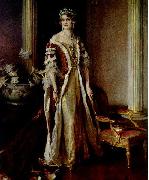 |
Philip Alexius de Laszlo
|
|
Philip Alexius de Laszlo, MVO (30 April 1869 Budapest - 22 November 1937 London) was a Hungarian painter known particularly for his portraits of royal and aristocratic personages.
Laszlo was born in Budapest as Laub Fulop Elek (Hungarian style with the surname first), the eldest son of a Jewish tailor. The family changed its name to Laszlo in 1891.
As a young man, Laszlo apprenticed to a photographer while studying art, eventually earning a place at the National Academy of Art, where he studied under Bertalan Szekely and Karoly Lotz. He followed this with studies in Munich and Paris. Laszlo's portrait of Pope Leo XIII earned him a Grand Gold Medal at the Paris International Exhibition in 1900.
In 1903 Laszlo moved from Budapest to Vienna. In 1907 he moved to England. He remained based in London for the rest of his life while traveling the world to fulfill commissions.
Laszlo's patrons awarded him numerous honors and medals. In 1909 he was named an honorary Member of the Royal Victorian Order by King Edward VII of the United Kingdom. In 1912 he was ennobled by King Franz Joseph of Hungary; his surname became "Laszlo de Lombos". The family later shortened the name to "de Laszlo".
Laszlo became a British citizen in 1914 but was interned for over twelve months in 1917 and 1918 during the First World War.
|
 |
Petere Lely
|
|
painted Julia Fasey, Lady Crewe in 17th century
|
 |
Ottavio Leoni
|
|
Ottavio Leoni (1578 - 1630) was an Italian painter and printmaker of the early-Baroque, active mainly in Rome.
He was born in Rome, where he first trained with his father, Lodovico Leoni. He painted altarpieces for churches in Rome such as an Annunciation for Sant'Eustachio and a Virgin and child with St. Giacinto for Santa Maria della Minerva, and a Saints Charles, Francis, & Nicholas for Sante Urbano. He became a member, and later president, of the Accademia di San Luca and a Cavalieri of the Order of Christ, on which occasion he presented the church of the Academy the Martyrdom of St. Martina. He died in Rome. Ottavio Leoni was also the engraver of a set of portraits of painters. His portrait of Michelangelo Merisi Caravaggio is the only documented portrait of the painter by another artist.
His work is exhibited in places such as Fine Arts Museums of San Francisco; Museum of Fine Arts, Boston; National Gallery of Art; Bowes Museum; Courtauld Institute of Art; Los Angeles County Museum of Art; and Palazzo Ruspoli, Rome, Italy. |
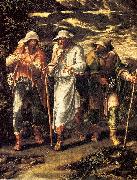 |
Orsi, Lelio
|
|
Italian, approx. 1508-87
.Italian painter and draughtsman. A prominent Emilian artist of the mid-16th century, he was influenced by Correggio as well as by the late Mannerist style of Giulio Romano. His large-scale works seem to have been mainly secular decorations, notably illusionistic fa?ades, of which only fragments are extant. Their energy and expressiveness are apparent, however, in the surviving paintings of smaller dimensions. Orsi's sole documented architectural work is the Collegiata di S Stefano, Novellara |
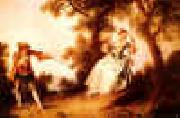 |
Nicolas Lancret
|
|
French
1690-1743
Nicolas Lancret (22 January 1690 ?C 14 September 1743), French painter, was born in Paris, and became a brilliant depicter of light comedy which reflected the tastes and manners of French society under the regent Orleans.
His first master was Pierre d'Ulin, but his acquaintance with and admiration for Watteau induced him to leave d'Ulin for Gillot, whose pupil Watteau had been. Two pictures painted by Lancret and exhibited on the Place Dauphine had a great success, which laid the foundation of his fortune, and, it is said, estranged Watteau, who had been complimented as their author.
Lancret's work cannot now, however, be taken for that of Watteau, for both in drawing and in painting his touch, although intelligent, is dry, hard and wanting in that quality which distinguished his great model; these characteristics are due possibly in part to the fact that he had been for some time in training under an engraver.
The number of his paintings (of which over eighty have been engraved) is immense; he executed a few portraits and attempted historical composition, but his favorite subjects were balls, fairs, village weddings, etc. The British Museum possesses an admirable series of studies by Lancret in red chalk, and the National Gallery, London, shows four paintings--the "Four Ages of Man" (engraved by Desplaces and l'Armessin), cited by d'Argenville amongst the principal works of Lancret. In 1719 he was received as Academician, and became councillor in 1735; in 1741 he married a grandchild of Boursault, author of Aesop at Court. |
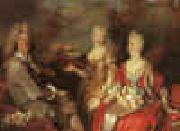 |
Nicolas de Largilliere
|
|
1656-1746
French
Nicolas de Largilliere Gallery
Nicolas de Largilli??re (October 10, 1656 - March 20, 1746), French painter, was born in Paris.
His father, a merchant, took him to Antwerp at the age of three. As a boy, he spent nearly two years in London. Sometime after his return to Antwerp, a failed attempt at business led him to the studio of Goubeau. However, Largilli??re left at the age of eighteen to seek his fortune in England, where he was befriended and employed by Lely, for four years at Windsor.
His skills attracted Charles II, who wished to retain him in his service, but the fury aroused by the Rye House Plot against Roman Catholics alarmed Largilli??re. He left for Paris where he was well received by Le Brun and Van der Meulen. Despite his Flemish training as a portrait-painter, his reputation was soon established. Largilli??re's brilliant colour and lively touch attracted celebrities of his day??actresses, public men and popular preachers flocked to his studio. President Lambert, with his beautiful wife and daughter, were among his most noted subjects. |
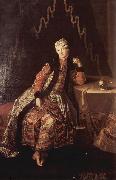 |
Nicolas de Largilliee
|
|
Largilliere's father, a merchant, took him to Antwerp at the age of three. As a boy, he spent nearly two years in London. Sometime after his return to Antwerp, a failed attempt at business led him to the studio of Goubeau. However, Largilliere left at the age of eighteen and went to England, where he was befriended and employed by Peter Lely for four years at Windsor, Berkshire.
Painting careerEarly careerHis painting caught the attention of Charles II, who wished to retain Largilliere in his service, but the controversy aroused by the Rye House Plot against Roman Catholics alarmed Largilliere. Largilliere left for Paris, where he was well-received by the public as a painter.
Upon ascending to the throne in 1685, James II requested Largilliere to return to England. James II offered Largilliere the office of keeper of the royal collections, but he declined due to being uneasy about Rye House Plot. However, during a short stay in London, he painted portraits of the king, the queen Mary of Modena, and the prince of Wales James Francis Edward Stuart. The portrait of the Prince of Wales could not have been painted during Largilliere's stay in London because the prince was not born until 1688. The three portraits painted by Largilliere of the prince in his youth must have been executed in Paris, where he returned sometime before March 1686. The portrait of King James II was painted in 1686. King James is portrayed in golden armor with a white cravat and is positioned in front of a watercolour-like background set in a round frame. |
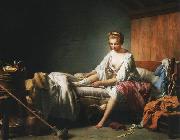 |
Nicolas Bernard Lepicie
|
|
was a French painter (16 June 1735 - 15 September 1784), the son of two reputed engravers at the time, Francois-Bernard and Renee-Elisabeth, was introduced to the artistic and cultural environment by his parents.
Nicolas-Bernard studied with reputed artists of the century including Carle Vanloo. In 1769 he was accepted to the Royal Academy of Painting and Sculpture in Paris. Three years later, in 1770, he became an assistant professor and, in 1777, a professor. Important names such as Carle Vernet, Jean-Frederic Schall, Jean-Antoine-Theodore Giroust, Jean-Joseph Taillasson, Henri-Pierre Danloux, Jean-Baptiste Regnault and Nicolas-Antoine. |
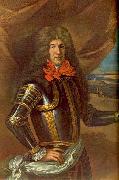 |
Musee national de la Marine
|
|
(National Navy Museum) is a maritime museum located in the Palais de Chaillot, Trocadero, in the XVIe arrondissement of Paris. It has annexes at Brest, Port-Louis, Rochefort (Musee National de la Marine de Rochefort), Toulon and Saint-Tropez. The permanent collection originates in a collection that dates back to Louis XV of France.
In 1748, Henri-Louis Duhamel du Monceau offered a collection of models of ships and naval installations to Louis XV of France, with the request that the items be displayed at the Louvre and made available to students of the Naval engineers school, which Duhamel headed. The collection was put on display in 1752, in a room of the first floor, next to the Academy of Sciences; the room was called "Salle de Marine" (Navy room), and was used for teaching.
With the French Revolution, the Salle de Marine closed in 1793. The collection was added to models owned by the King personally, to others owned by the Ministry of Navy, and yet others owned by emigres or executees (notably Philippe Égalite). A short-lived museum was opened between 1801 and 1803 at the Ministry of Navy, then located at Place de la Concorde.
|
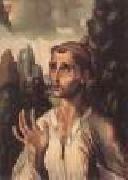 |
MORALES, Luis de
|
|
Spanish Mannerist Painter, ca.1520-1586
Spanish painter. The origins of his highly individual style are complex. His meticulous technique and the prominent echoes of the style and forms of Leonardo da Vinci and Raphael indicate the formative influence of Italianizing Flemish painters. This accords with Palomino's statement that Morales was trained in Seville by the Flemish Mannerist painter Peeter de Kempeneer (known in Spain as Pedro de Campara), who is recorded in Spain from 1537. It has been suggested that Morales visited Italy c. 1540, but this seems most unlikely. |
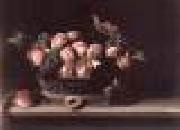 |
MOILLON, Louise
|
|
French Baroque Era Painter, ca.1610-1696
French painter. She was the daughter of the Protestant Nicolas Moillon (1555-1619), a painter of portraits and landscapes, picture-dealer and member of the Acad?mie de St Luc. She grew up in the St-Germain-des-Pr?s district of Paris, which, from the beginning of the 17th century, was a centre for painters from the southern Netherlands seeking refuge from religious persecution. Flemish influences appear in her still-life work, a specialization in which she followed her stepfather, |
 |
Merson, Luc-Olivier
|
|
French Painter, 1846-1920
French painter and illustrator. He was the son of the painter and art critic Charles-Olivier Merson (1822-1902) and trained initially at the Ecole de Dessin in Paris under Gustave Adolphe Chassevent (1818-1901) and then at the Ecole des Beaux-Arts under Isidore-Alexandre-Augustin Pils. He made his d?but at the Salon in 1867 and won the Grand Prix de Rome in 1869 with the melodramatic work, the Soldier of Marathon (1869; Paris, Ecole N. Sup. B.-A.). As a prizewinner he then spent five years in Italy, where he was impressed and influenced by the works of the Italian Primitives, as is apparent in such works as St Edmund, King and Martyr (1871; Troyes, Mus. B.-A. & Arch?ol.), with its muted colours and rigid composition. In the Salon of 1875 he exhibited Sacrifice for the Country, St Michael, which had been commissioned as a design for a Gobelins tapestry for the Salle des Ev?ques in the Panth?on, Paris. Soon afterwards he was chosen to decorate the Galerie de St Louis in the Palais de Justice, Paris, with scenes from the life of Louis IX. This resulted in two large works, Louis Opening the Doors of the Gaols on his Accession and Louis Condemning Sire Enguerrand de Coucy (both 1877). He also used historical, often religious, subjects for his smaller-scale works, as in St Francis of Assisi Preaching to the Fish (1880; Nantes, Mus. B.-A.). |
|

